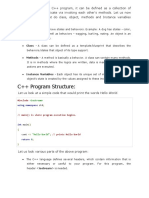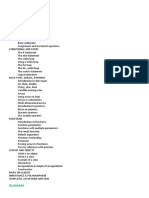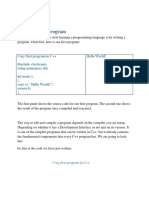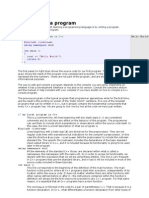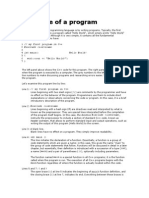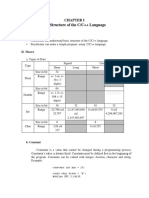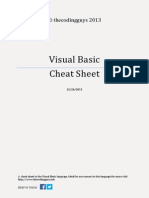CPP Basic Syntax
Uploaded by
lojo123CPP Basic Syntax
Uploaded by
lojo123C++ BASIC SYNTAX
http://www.tuto rialspo int.co m/cplusplus/cpp_basic_syntax.htm
Co pyrig ht tuto rials po int.co m
When we consider a C++ prog ram, it can be defined as a collection of objects that communicate via invoking
each other's methods. Let us now briefly look into what do class, object, methods and instant variables mean.
O bjec t - Objects have states and behaviors. Example: A dog has states - color, name, breed as well as
behaviors - wag g ing , barking , eating . An object is an instance of a class.
Class - A class can be defined as a template/blueprint that describes the behaviors/states that object of
its type support.
Methods - A method is basically a behavior. A class can contain many methods. It is in methods where the
log ics are written, data is manipulated and all the actions are executed.
Instant Variables - Each object has its unique set of instant variables. An object's state is created by
the values assig ned to these instant variables.
C++ Prog ram Structure:
Let us look at a simple code that would print the words Hello World.
#include <iostream>
using namespace std;
// main() is where program execution begins.
int main()
{
cout << "Hello World"; // prints Hello World
return 0;
}
Let us look various parts of the above prog ram:
T he C++ lang uag e defines several headers, which contain information that is either necessary or useful to
your prog ram. For this prog ram, the header <iostream> is needed.
T he line using namespac e std; tells the compiler to use the std namespace. Namespaces are a
relatively recent addition to C++.
T he next line // main() is where prog ram exec ution beg ins. is a sing le-line comment available in
C++. Sing le-line comments beg in with // and stop at the end of the line.
T he line int main() is the main function where prog ram execution beg ins.
T he next line c out << "T his is my first C++ prog ram."; causes the messag e "T his is my first C++
prog ram" to be displayed on the screen.
T he next line return 0; terminates main( )function and causes it to return the value 0 to the calling
process.
Compile & Execute C++ Prog ram:
Let's look at how to save the file, compile and run the prog ram. Please follow the steps g iven below:
Open a text editor and add the code as above.
Save the file as: hello.cpp
Open a command prompt and g o to the directory where you saved the file.
T ype 'g ++ hello.cpp ' and press enter to compile your code. If there are no errors in your code the
command prompt will take you to the next line and would g enerate a.out executable file.
Now, type ' a.out' to run your prog ram.
You will be able to see ' Hello World ' printed on the window.
$ g++ hello.cpp
$ ./a.out
Hello World
Make sure that g ++ is in your path and that you are running it in the directory containing file hello.cpp.
You can compile C/C++ prog rams using makefile. For more details, you can check Makefile T utorial.
Semicolons & Blocks in C++:
In C++, the semicolon is a statement terminator. T hat is, each individual statement must be ended with a
semicolon. It indicates the end of one log ical entity.
For example, following are three different statements:
x = y;
y = y+1;
add(x, y);
A block is a set of log ically connected statements that are surrounded by opening and closing braces. For
example:
{
cout << "Hello World"; // prints Hello World
return 0;
}
C++ does not recog nize the end of the line as a terminator. For this reason, it does not matter where on a line
you put a statement. For example:
x = y;
y = y+1;
add(x, y);
is the same as
x = y; y = y+1; add(x, y);
C++ Identifiers:
A C++ identifier is a name used to identify a variable, function, class, module, or any other user-defined item. An
identifier starts with a letter A to Z or a to z or an underscore (_) followed by zero or more letters, underscores,
and dig its (0 to 9).
C++ does not allow punctuation characters such as @, $, and % within identifiers. C++ is a case-sensitive
prog ramming lang uag e. T hus, Manpower and manpower are two different identifiers in C++.
Here are some examples of acceptable identifiers:
mohd
myname50
zara
_temp
abc
j
move_name
a23b9
a_123
retVal
C++ Keywords:
T he following list shows the reserved words in C++. T hese reserved words may not be used as constant or
variable or any other identifier names.
asm
else
new
this
auto
enum
operator
throw
bool
explicit
private
true
break
export
protected
try
case
extern
public
typedef
catch
false
reg ister
typeid
char
float
reinterpret_cast
typename
class
for
return
union
const
friend
short
unsig ned
const_cast
g oto
sig ned
using
continue
if
sizeof
virtual
default
inline
static
void
delete
int
static_cast
volatile
do
long
struct
wchar_t
double
mutable
switch
while
dynamic_cast
namespace
template
Trig raphs:
A few characters have an alternative representation, called a trig raph sequence. A trig raph is a three-character
sequence that represents a sing le character and the sequence always starts with two question marks.
T rig raphs are expanded anywhere they appear, including within string literals and character literals, in
comments, and in preprocessor directives.
Following are most frequently used trig raph sequences:
T rig raph
Replac ement
??=
??/
??'
??(
??)
??!
??<
??>
??-
All the compilers do not support trig raphs and they are not advised to be used because of their confusing nature.
Whitespace in C++:
A line containing only whitespace, possibly with a comment, is known as a blank line, and C++ compiler totally
ig nores it.
Whitespace is the term used in C++ to describe blanks, tabs, newline characters and comments. Whitespace
separates one part of a statement from another and enables the compiler to identify where one element in a
statement, such as int, ends and the next element beg ins. T herefore, in the statement,
int age;
there must be at least one whitespace character (usually a space) between int and ag e for the compiler to be able
to disting uish them. On the other hand, in the statement
fruit = apples + oranges;
// Get the total fruit
no whitespace characters are necessary between fruit and =, or between = and apples, althoug h you are free to
include some if you wish for readability purpose.
You might also like
- WINSEM2023-24 BCSE102L TH VL2023240501147 2024-03-06 Reference-Material-IINo ratings yetWINSEM2023-24 BCSE102L TH VL2023240501147 2024-03-06 Reference-Material-II125 pages
- Lab N O. 8: Introduction To Fundamentals of C++ Programing Pre Lab TaskNo ratings yetLab N O. 8: Introduction To Fundamentals of C++ Programing Pre Lab Task16 pages
- Name of University: COURSE CODE: Course NameNo ratings yetName of University: COURSE CODE: Course Name12 pages
- Chapter Three Fundamentals of The C/C++ Programming LanguageNo ratings yetChapter Three Fundamentals of The C/C++ Programming Language23 pages
- Microsoft Press - Visual C++.NET Step by Step PDFNo ratings yetMicrosoft Press - Visual C++.NET Step by Step PDF68 pages
- C++ Programming:: From Problem Analysis To Program DesignNo ratings yetC++ Programming:: From Problem Analysis To Program Design30 pages
- C++ Basic Syntax Lecture 1C: Using Namespace Int ReturnNo ratings yetC++ Basic Syntax Lecture 1C: Using Namespace Int Return6 pages
- (Lecture-1) Topic: Introduction of C++: EE 355 A: Computer Programming in C++ (E)No ratings yet(Lecture-1) Topic: Introduction of C++: EE 355 A: Computer Programming in C++ (E)10 pages
- #Include Using Namespace Int: Basic Program ConstructionNo ratings yet#Include Using Namespace Int: Basic Program Construction7 pages
- Lesson 1: The Basics of C++: Getting Set Up - C++ Compilers100% (1)Lesson 1: The Basics of C++: Getting Set Up - C++ Compilers5 pages
- c++ notes pdf complete object oriented programmingNo ratings yetc++ notes pdf complete object oriented programming82 pages
- PROGRAMMING WITH PYTHON: Master the Basics and Beyond with Hands-On Projects and Expert Guidance (2024 Guide for Beginners)From EverandPROGRAMMING WITH PYTHON: Master the Basics and Beyond with Hands-On Projects and Expert Guidance (2024 Guide for Beginners)No ratings yet
- C Language Preliminaries: C-Programming Tutorial 1. Introduction and Basics of CNo ratings yetC Language Preliminaries: C-Programming Tutorial 1. Introduction and Basics of C13 pages
- Sample Question Paper - Object Oriented Programming-1206350% (2)Sample Question Paper - Object Oriented Programming-120634 pages
- Guido Van Rossum, Fred L. Drake, JR., (Editor) - Python Tutorial. Release 3.2.3 (2012, Python Software Foundation)No ratings yetGuido Van Rossum, Fred L. Drake, JR., (Editor) - Python Tutorial. Release 3.2.3 (2012, Python Software Foundation)105 pages
- Assignment # 1: BS-Software Engineering Section XNo ratings yetAssignment # 1: BS-Software Engineering Section X34 pages
- Standards Compliance According To IEC 61131-3No ratings yetStandards Compliance According To IEC 61131-311 pages
- 03.string - Manipulations - and - Boolean - Datatype - Jupyter NotebookNo ratings yet03.string - Manipulations - and - Boolean - Datatype - Jupyter Notebook46 pages
- The Basic Structure of The C/C++ Language: I. ObjectivesNo ratings yetThe Basic Structure of The C/C++ Language: I. Objectives8 pages
- English Shorthand (R) Alphabet PhraseographyNo ratings yetEnglish Shorthand (R) Alphabet Phraseography5 pages
- Visual Basic Cheat Sheet: © Thecodingguys 2013No ratings yetVisual Basic Cheat Sheet: © Thecodingguys 201314 pages
- Prelim Examination ITELEC3 - ITE ELECTIVE03 (Python Programming)No ratings yetPrelim Examination ITELEC3 - ITE ELECTIVE03 (Python Programming)7 pages
- Alphabet Series Ultra Bundle PDF For Upcoming Bank Prelims ExamsNo ratings yetAlphabet Series Ultra Bundle PDF For Upcoming Bank Prelims Exams66 pages






